Archaeology
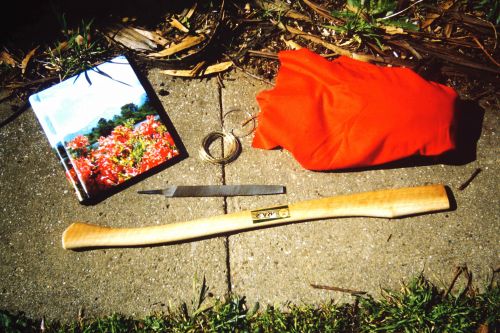
MODERN TRADE GOODS FROM THE WINNUN CYCLE
Modern trade and exchange goods from a winnun cycle in 1986.
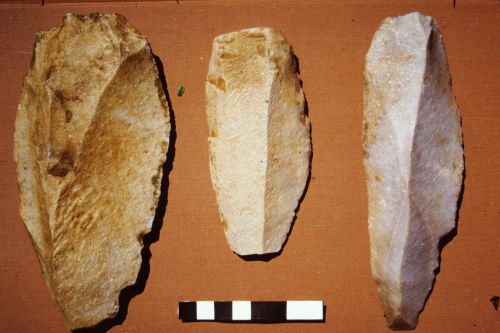
LEILIRA BLADES USED IN THE WINNUN CYCLE
Leilira blades used in the winnun trade and exchange cycle. The blades are an important component of the Pelican Dreaming history.
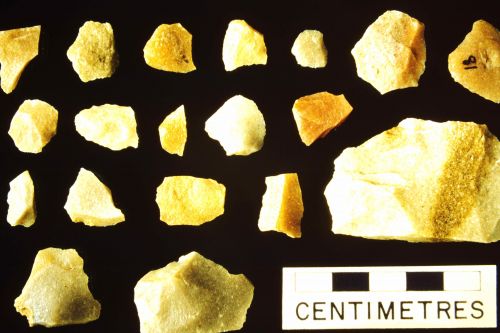
LEILIRA BLADE SEGMENTS
Leilira blade segments caused by the deliberate snapping of the blades as part of winnun. Important Dreaming histories are associated with the various trade goods. These stories travel with the goods as a part of the trade cycle called Winnun. Leilira blades are closely associated with the Pelican Dreaming. In the Pelican Dreaming history, one blade on top of the other forms the pelican beak.

LEILIRA BLADE CORE
This is the parent rock that the Leilira blades are made from. It is known as a core. You can see the negative scars where the blades were removed by a method called direct percussion.
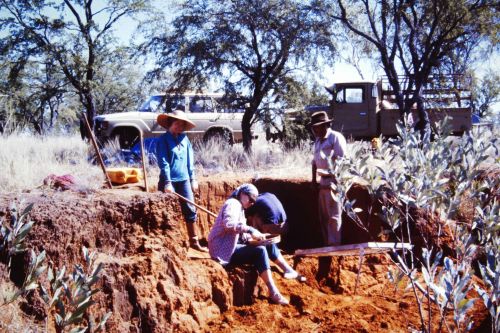
ARCHAEOLOGICAL EXCAVATION LAKE WOODS
Archaeological excavation at Lake Woods with dig Director Mike Smith. Lake Woods is near Newcastle Waters. The photograph is taken in 1986. Other people on the dig included Rob Paton, Ingereth Macfarlane, Louis Napton, Robyn Simms and Denise Donlan.
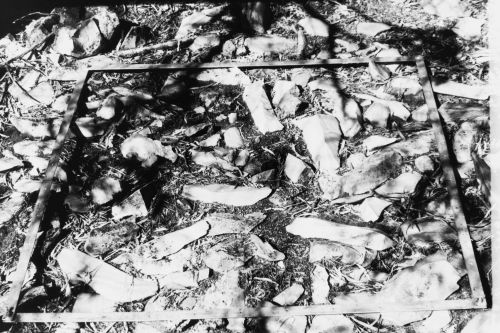
LEILIRA BLADE QUARRY
Leilira blade quarry called Kankiritja (or pelican landing place). Important Dreaming histories are associated with the various trade goods. These stories travel with the goods as a part of the trade cycle called Winnun. Leilira blades are closely associated with the Pelican Dreaming. In the Pelican Dreaming history, one blade on top of the other forms the pelican beak.
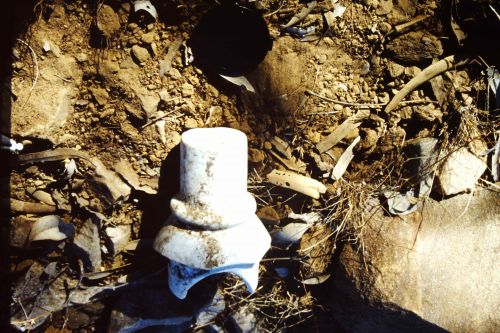
INSULATOR USED TO MAKE TOOLS
Insulator used to make tools. This came from the old overland telegraph line, near Newcastle Waters. The photograph was taken in 1985.
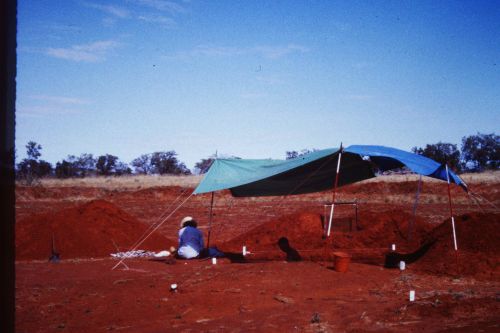
ARCHAEOLOGICAL EXCAVATION LAKE WOODS
Archaeological excavation at Lake Woods near Newcastle Waters, 1986. The dig was directed by archaeologist Mike Smith.

NUGGETT COLLINS AT YIPITJIRINTJA LEILIRA BLADE QUARRY.
Nuggett Collins at Yipitjirintja Leilira blade quarry, 1985.

LEILIRA BLADE
Leilira blade. Important Dreaming histories are associated with the various trade goods. These stories travel with the goods as a part of the trade cycle called Winnun. Leilira blades are closely associated with the Pelican Dreaming. In the Pelican Dreaming history, one blade on top of the other forms the pelican beak.

LEILIRA BLADE SEGMENT
Leilira blade segment resulting from the deliberate snapping of the blades as part of the winnun exchange system.
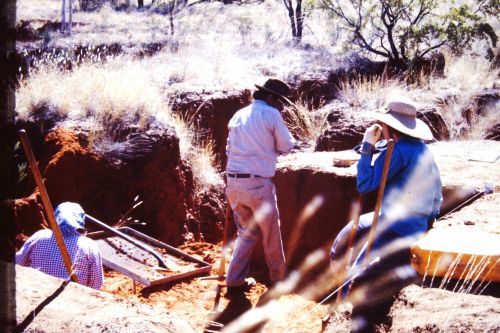
LAKE WOODS EXCAVATION
Lake Woods excavation, 1986. Director Mike Smith. People in this photograph are Louis Napton, Robyn Simms and Denise Donlan.

MAKING LEILIRA BLADES
Larry Brandy and Nuggett Collins burning rock to make Leilira blades, 1986. This is a Pelican Dreaming site called Kankiritja.
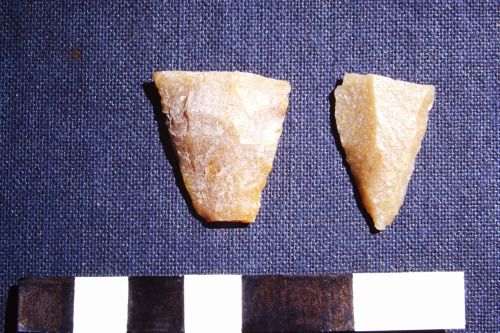
LEILIRA BLADE SEGMENTS
Leilira blade segments caused by the deliberate snapping of the blades as part of the winnun exchange cycle.
Google Maps Location
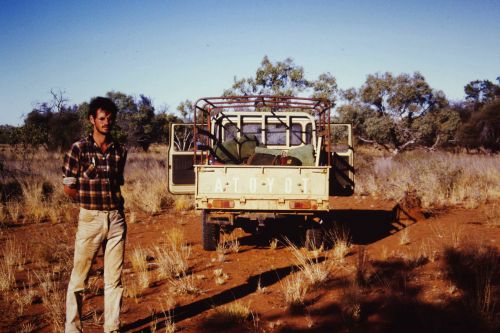
ROB PATON 1985
Rob Paton 1985 recording a Leilira blade quarry.

MODERN TRADE GOODS FROM THE WINNUN CYCLE
Modern trade and exchange goods from a winnun cycle in 1986.

LEILIRA BLADES USED IN THE WINNUN CYCLE
Leilira blades used in the winnun trade and exchange cycle. The blades are an important component of the Pelican Dreaming history.

LEILIRA BLADE SEGMENTS
Leilira blade segments caused by the deliberate snapping of the blades as part of winnun. Important Dreaming histories are associated with the various trade goods. These stories travel with the goods as a part of the trade cycle called Winnun. Leilira blades are closely associated with the Pelican Dreaming. In the Pelican Dreaming history, one blade on top of the other forms the pelican beak.

LEILIRA BLADE CORE
This is the parent rock that the Leilira blades are made from. It is known as a core. You can see the negative scars where the blades were removed by a method called direct percussion.

ARCHAEOLOGICAL EXCAVATION LAKE WOODS
Archaeological excavation at Lake Woods with dig Director Mike Smith. Lake Woods is near Newcastle Waters. The photograph is taken in 1986. Other people on the dig included Rob Paton, Ingereth Macfarlane, Louis Napton, Robyn Simms and Denise Donlan.

LEILIRA BLADE QUARRY
Leilira blade quarry called Kankiritja (or pelican landing place). Important Dreaming histories are associated with the various trade goods. These stories travel with the goods as a part of the trade cycle called Winnun. Leilira blades are closely associated with the Pelican Dreaming. In the Pelican Dreaming history, one blade on top of the other forms the pelican beak.

INSULATOR USED TO MAKE TOOLS
Insulator used to make tools. This came from the old overland telegraph line, near Newcastle Waters. The photograph was taken in 1985.

ARCHAEOLOGICAL EXCAVATION LAKE WOODS
Archaeological excavation at Lake Woods near Newcastle Waters, 1986. The dig was directed by archaeologist Mike Smith.

NUGGETT COLLINS AT YIPITJIRINTJA LEILIRA BLADE QUARRY.
Nuggett Collins at Yipitjirintja Leilira blade quarry, 1985.

LEILIRA BLADE
Leilira blade. Important Dreaming histories are associated with the various trade goods. These stories travel with the goods as a part of the trade cycle called Winnun. Leilira blades are closely associated with the Pelican Dreaming. In the Pelican Dreaming history, one blade on top of the other forms the pelican beak.

LEILIRA BLADE SEGMENT
Leilira blade segment resulting from the deliberate snapping of the blades as part of the winnun exchange system.

LAKE WOODS EXCAVATION
Lake Woods excavation, 1986. Director Mike Smith. People in this photograph are Louis Napton, Robyn Simms and Denise Donlan.

MAKING LEILIRA BLADES
Larry Brandy and Nuggett Collins burning rock to make Leilira blades, 1986. This is a Pelican Dreaming site called Kankiritja.

LEILIRA BLADE SEGMENTS
Leilira blade segments caused by the deliberate snapping of the blades as part of the winnun exchange cycle.

MAKING LEILIRA BLADES
Larry Brandy and Nuggett Collins burning rock to make Leilira blades, 1986. The rock is burnt to help remove natural micro-fractures prior to blade manufacture. This is an important Pelican Dreaming site and the firing of the rock is part of the Pelican History for this place.

MAKING LEILIRA BLADES
Larry Brandy and Nuggett Collins burning rock to make Leilira blades, 1986. The rock is burnt to enhance its flaking qualities through the removal of natural micro-fractures. This is an important Pelican Dreaming site called Ipitjirintja (which is also a fly Dreaming).